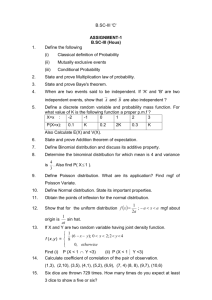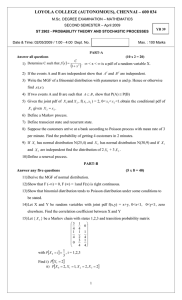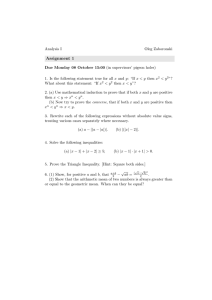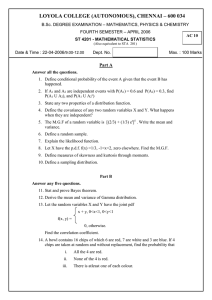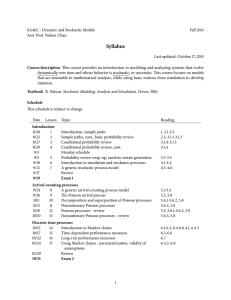Document 15510708
advertisement
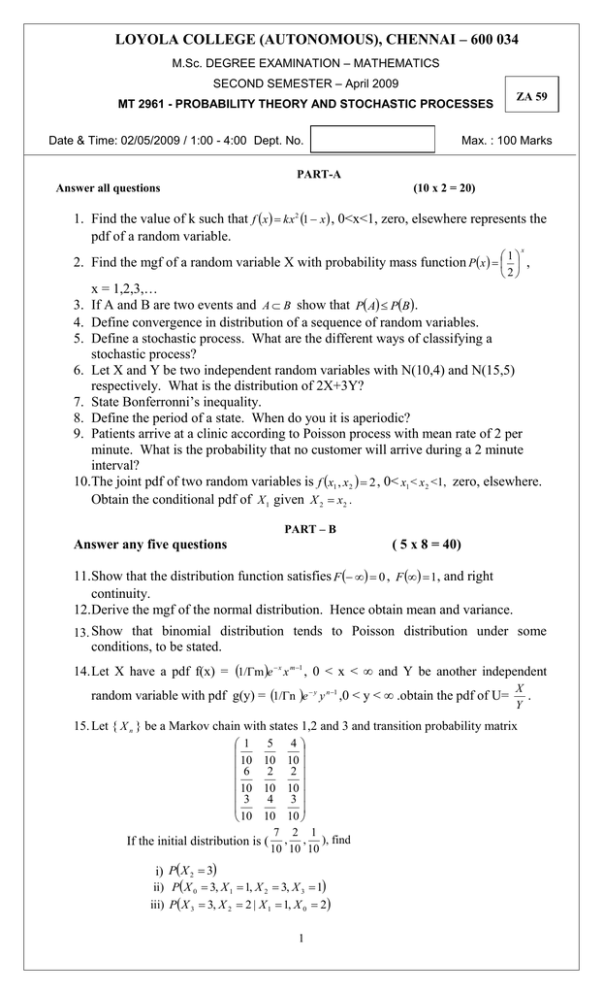
LOYOLA COLLEGE (AUTONOMOUS), CHENNAI – 600 034
M.Sc. DEGREE EXAMINATION – MATHEMATICS
SECOND SEMESTER – April 2009
MT 2961 - PROBABILITY THEORY AND STOCHASTIC PROCESSES
Date & Time: 02/05/2009 / 1:00 - 4:00 Dept. No.
ZA 59
Max. : 100 Marks
PART-A
Answer all questions
(10 x 2 = 20)
1. Find the value of k such that f x kx2 1 x , 0<x<1, zero, elsewhere represents the
pdf of a random variable.
x
1
2. Find the mgf of a random variable X with probability mass function Px ,
2
x = 1,2,3,…
3. If A and B are two events and A B show that P A PB.
4. Define convergence in distribution of a sequence of random variables.
5. Define a stochastic process. What are the different ways of classifying a
stochastic process?
6. Let X and Y be two independent random variables with N(10,4) and N(15,5)
respectively. What is the distribution of 2X+3Y?
7. State Bonferronni’s inequality.
8. Define the period of a state. When do you it is aperiodic?
9. Patients arrive at a clinic according to Poisson process with mean rate of 2 per
minute. What is the probability that no customer will arrive during a 2 minute
interval?
10.The joint pdf of two random variables is f x1 , x2 2 , 0< x1 < x 2 <1, zero, elsewhere.
Obtain the conditional pdf of X 1 given X 2 x2 .
PART – B
Answer any five questions
( 5 x 8 = 40)
11.Show that the distribution function satisfies F 0 , F 1, and right
continuity.
12.Derive the mgf of the normal distribution. Hence obtain mean and variance.
13. Show that binomial distribution tends to Poisson distribution under some
conditions, to be stated.
14. Let X have a pdf f(x) = 1/me x x m1 , 0 < x < ∞ and Y be another independent
random variable with pdf g(y) = 1/n e y y n 1 ,0 < y < ∞ .obtain the pdf of U=
X
.
Y
15. Let { X n } be a Markov chain with states 1,2 and 3 and transition probability matrix
1 5 4
10 10 10
6 2 2
10 10 10
3 4 3
10 10 10
7 2 1
If the initial distribution is ( , , ), find
10 10 10
i) P X 2 3
ii) P X 0 3, X 1 1, X 2 3, X 3 1
iii) P X 3 3, X 2 2 | X 1 1, X 0 2
1
16. Derive the expression for Pn t in a pure birth process with X(0) =0
17. Let X and Y have the joint pdf f x, y 21x 2 y 3 ,0 x y 1 ,zero, elsewhere.
Find
E[Y|x].
18. Prove that E(XY) = E(X) E(Y) when the random variables are continuous and
independent. Is the converse true? Justify.
PART – C
Answer any two questions
( 2 x 20 = 40)
19.a) State and prove Baye’s theorem.
b) Give an example to show that pair wise independence does not
imply
independence of three events.
c). State and prove Boole’s Inequality.
( 8 + 6 + 6)
20. a) State and prove Markov inequality. Deduce Chebyshev’s inequality.
b). Show that almost sure convergence implies convergence in probability. Is
the converse true? Justify.
c). State and prove central limit theorem for a sequence of i.i.d random variables.
( 5 + 5 + 10 )
21. (a). State the postulates of Poisson process and derive an expression for Pn t .
(b). Obtain the pgf of a Poisson process. If X 1 t and X 2 t have
independent Poisson processes with parameters 1 and 2 respectively,
find PX 1 t k | X 1 t X 2 t n.
( 6 + 5+ 9)
22. a). Show that the Markov chain with the transition probability matrix
0
0
0
1
2
0
0
1
1
8
1
0
0
1
8
0
1
0
1
4
is ergodic. Obtain the stationary distribution.
b). Show that communication is an equivalence relation.
c). Let X n be the minimum obtained while throwing a die n-times.
Obtain the transition probability matrix.
( 12 + 4 + 4)
*****************
2
